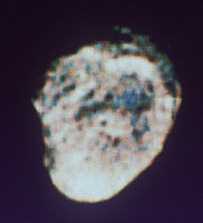What's New on the Site?
When Nature Strikes - Earthquakes
When Nature Strikes - Volcanoes
When Nature Strikes: Tsunami Classroom Activity
When Nature Strikes: Wildfires - Why are they a challenge to stop?
Windows to the Universe Community | |
News | Opportunities |
You might also be interested in:

The Surface of Rhea
The surface of Rhea is typical of an icy moon. Rhea is as heavily cratered (despite the appearance of this picture) as Saturn's "death star" moon Mimas on its leading side. Its trailing side has unusual...more
Dione
Dione was discovered by G. Cassini in 1684. Dione is the 7th farthest moon from Saturn, with a standoff distance of 377,400 km. It is a small icy moon, lightly cratered, with wispy white streaks across...more
A Comparison of Saturn's Icy Moons, and the Earth's Moon
This is an image of the Earth's moon, shown in the lower left, with the much smaller icy moons of Saturn. The moons in order, starting from the top left are: Mimas, Enceladus, Tethys, Dione, Rhea, and...more
The Surface of Dione
The surface of Dione does not have many craters. Instead it has wispy white streaks similar to those found on Rhea extending for many kilometers over the entire surface. These two things indicate that...more
The Surface of Enceladus
The surface of Enceladus does not have many craters. Instead it has grooves similar to those found on Ganymede. These grooves extend for many kilometers over the surface. The presence of grooves indicates...more
Helene
Helene was discovered by the French astronomers Pierre Laques, Raymond Despiau and J. Lecacheux on February 29, 1980. Even though Helene is so far away, they were able to make their discovery at an observatory...morePlease log in
Science Blogs
Real Climate: climate science from climate scientists

Windows to the Universe, a project of the National Earth Science Teachers Association, is sponsored in part is sponsored in part through grants from federal agencies (NASA and NOAA), and partnerships with affiliated organizations, including the American Geophysical Union, the Howard Hughes Medical Institute, the Earth System Information Partnership, the American Meteorological Society, the National Center for Science Education, and TERC. The American Geophysical Union and the American Geosciences Institute are Windows to the Universe Founding Partners. NESTA welcomes new Institutional Affiliates in support of our ongoing programs, as well as collaborations on new projects. Contact NESTA for more information.






